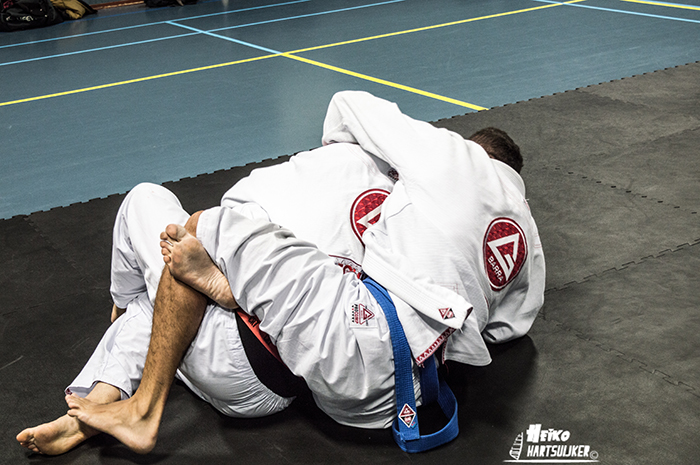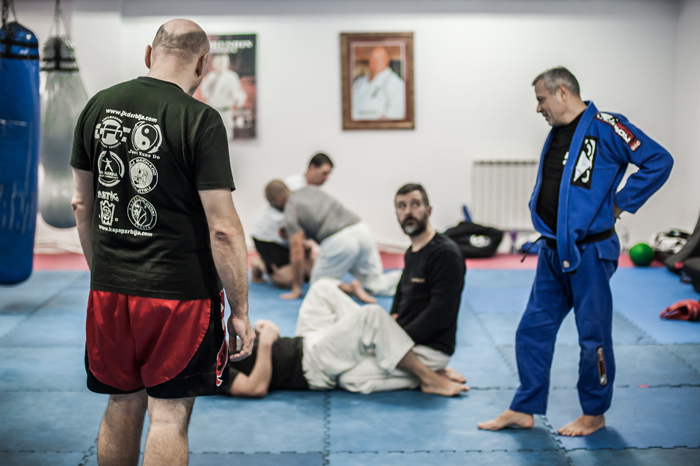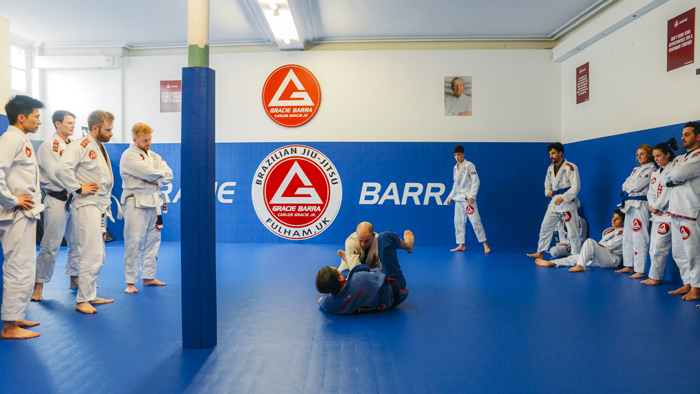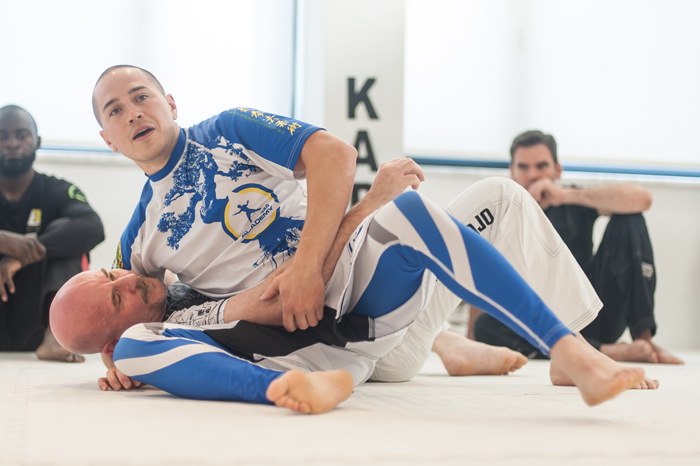Brazilian Jiu-Jitsu: A Complete Guide to the Martial Art
Brazilian jiu-jitsu is a martial art famous for its strategic ground fighting and submission techniques. It is popular for both self-defense and sports. This guide covers the essentials of Brazilian jiu-jitsu (BJJ), exploring its international success from traditional Japanese roots and how it has become a world-famous sport. If you’re looking to begin your journey or learn more about BJJ’s practical techniques and philosophy, then this is the guide for you. Let’s get started!
Exploring Brazilian Jiu-Jitsu’s Principles

BJJ has a rich heritage derived from Japanese jiu-jitsu and has been greatly influenced by the Gracie family and Mitsuyo Maeda. These pioneers of Brazilian jiu-jitsu evolved into a highly competitive sport.
The submission techniques of Brazilian jiu-jitsu prioritize control and leverage over opponents, which makes it a very strategic and technical discipline. BJJ practitioners learn various grappling techniques to force opponents into submission.
In contrast to many martial arts that depend on explosive movements and strikes, BJJ emphasizes patience, control, and strategic thinking. It takes a sense of mental sharpness and critical thinking to anticipate and counter an opponent’s movements. Because of this aspect of strategic thinking, BJJ is often likened to ‘human chess’.
BJJ’s effectiveness is attributed to its strategic approach, which prioritizes control and position dominance instead of swift victories. It is a martial art that takes time and patience to master, and even when mastered, it still takes patience and strategy to gain a victory over high-level opponents.
BJJ as a Modern Martial Art
Brazilian jiu-jitsu has evolved over time into a modern martial art that is practiced both as a form of self-defense and as a sport. It has incorporated unique techniques and elements from various disciplines, including judo, wrestling, and Japanese jiu-jitsu. This rich blend of influences has created a dynamic and versatile martial art capable of handling a wide range of combat scenarios. As a result, Brazilian jiu-jitsu presents an exciting and effective approach to grappling.
The wide range of techniques in BJJ training demonstrates its adaptability, an adaptability that has made it vital to the training of mixed martial arts fighters. Today, BJJ is used worldwide among mixed martial arts fighters and is seen as the strongest base for ground fighting.
The Evolution of Brazilian Jiu-Jitsu

The art of Japanese jiu-jitsu has a rich history that dates back to the 17th century AD in Japan. Originally practiced by samurai warriors, it encapsulated various grappling disciplines and was a vital part of their combat skills. During Japan’s peaceful Edo period, the development and diversification of jiu-jitsu continued, leading to the emergence of a wide variety of styles throughout the country. As a result, jiu-jitsu practitioners have a diverse range of techniques and styles to choose from.
The journey of jiu jitsu, from its early adoption in Japanese martial arts to today’s global practice as Brazilian jiu-jitsu, demonstrates its adaptive nature. Over the centuries, it has absorbed elements from various martial arts, evolving and refining its techniques to become the effective combat system it is today. Although Japanese jiu jitsu incorporates striking techniques, Brazilian jiu jitsu does not use any strikes. It has been refined and evolved into a martial art that is purely grappling-based.
Mitsuyo Maeda: The Catalyst
Mitsuyo Maeda, an expert in Japanese Judo, played an important role in Jiu Jitsu’s evolution. He brought his teachings to Brazil, where he taught Carlos Gracie, who later became one of the key figures in developing Brazilian jiu-jitsu. Maeda’s teachings bridged the gap between traditional Japanese practices and the new Brazilian variation, laying the foundation for BJJ and inspiring future jiu jitsu masters.
His philosophy, which focused on the nature of combat, honed through his worldwide travels and competitions against various martial arts, greatly influenced the principles of control and leverage that are key to BJJ.
The Gracie Influence: Carlos and Helio’s Legacy
Carlos Gracie and Helio Gracie are two of the greatest pioneers of Brazilian jiu-jitsu. The Gracie brothers are responsible for the popularization of BJJ, along with Mitsuyo Maeda; they are considered to be the founders of BJJ. Helio, in particular, adapted traditional techniques to suit smaller practitioners. Despite his smaller stature, he emphasized leverage and strategy over strength, allowing BJJ to be effectively practiced by individuals of all sizes.
Their legacy continues to shape the world of BJJ, with Renzo Gracie and the Gracie family still being revered in the martial arts community.
Ground Fighting: The Core of BJJ
The foundation of Brazilian jiu-jitsu is ground fighting. BJJ revolves around the concept of a smaller, weaker person defending against a larger, stronger opponent using leverage and weight distribution to gain an advantage. It’s a martial art that uses the principles of physics to maximize control and minimize risk.
Key Techniques and Positions in Brazilian Jiu Jitsu
Brazilian jiu-jitsu is a technical martial art that requires understanding of a variety of positions and techniques. You will not be expected to learn these when starting out your BJJ journey, but over time, with practice, you will become familiar with many of these techniques and positions. Here is a list of the fundamental BJJ techniques and positions:
Positions
- Guard
- Closed Guard
- Open Guard
- Half Guard
- Butterfly Guard
- Spider Guard
- De La Riva Guard
- Worm Guard
Mount
- Full Mount
- Low Mount
- S-Mount
- Side Control
- Traditional Side Control
- Knee on Belly
- North-South
- Back Control
- Seat Belt Grip
- Hooks In
Chokeholds
- Rear Naked Choke
- Guillotine Choke
- Triangle Choke
- Bow and Arrow Choke
- Ezekiel Choke
Joint Locks
- Armbar
- Kimura
- Americana
- Omoplata
- Heel Hook
Sweeps
- Scissor Sweep
- Hip Bump Sweep
- Flower Sweep
- X-Guard Sweep
- Berimbolo
Escapes
- Shrimp Escape
- Bridge and Roll Escape
- Elbow Escape
- Knee Push Escape
- Turtle Escape
Transitions
- Passing the Guard
- Leg Drag
- Knee Cut Pass
- Pressure Pass
- Over-Under Pass
- Taking the Back
- Transition to Mount
- Knee on Belly Transition
Takedowns
- Single Leg Takedown
- Double Leg Takedown
- Judo Throw (e.g., Osoto Gari)
- Ankle Pick
These techniques and positions form the foundation of Brazilian jiu-jitsu. Dominant positions such as the full mount, side control, knee on belly, and back mount all play critical roles in BJJ ground fighting. These allow for superior control over the opponent and the setup of various submissions like armbars, chokes, and joint locks. Like many grappling martial arts, the techniques of BJJ are complex at first, but through practice, they become second nature.
Path to the Black Belt: BJJ Grading Explained
The journey towards mastering Brazilian jiu-jitsu is represented by a black belt. However, getting there is not easy. It requires years of dedication, discipline, and hard work. BJJ practitioners are awarded colored belts to signify their progression, starting from white and moving through to:
- blue
- purple
- brown
- and ultimately the black belt.
Each belt has five levels, indicated by four stripes, that can be earned through a combination of:
- Time
- Knowledge
- Behavior
- Competition performance
The journey to black belt in Brazilian jiu-jitsu takes an average of 10 years with a consistent training schedule, although it can range from 8 to 15 years, depending on various factors.
Achieving a black belt in Brazilian jiu-jitsu represents an expert level of proficiency and is considered a great honor. Considering it takes years of learning jiu-jitsu to achieve this, a black belt is a highly respected status amongst Brazilian Jiu Jitsu practitioners.
Selecting Your Dojo: Choosing a Brazilian Jiu Jitsu Academy

Selecting an appropriate jiu-jitsu academy is an important step in your BJJ journey. The right academy can significantly influence your learning experience and progression in the martial arts. When selecting an academy, students should choose one that offers a curriculum and classes that match their personal goals, whether it’s for self-defense, fitness, competition, or as a casual hobby.
The quality of instruction at a jiu-jitsu academy can be determined by the qualifications of the head instructor, their belt rank, lineage, and teaching approach. Choosing an academy with a supportive training environment, an easily accessible location, and a class schedule that fits your lifestyle are additional factors to consider when choosing a jiu-jitsu academy.
Integrating Brazilian Jiu Jitsu and MMA
The blend of Brazilian Jiu Jitsu, Muay Thai, and wrestling has created modern mixed martial arts (MMA). While some mixed martial arts practitioners use other forms of submission arts like sambo, most fighters tend to use Brazilian jiu-jitsu as their base. BJJ became internationally recognized after Royce Gracie’s success in the early UFC events, demonstrating the effectiveness of ground fighting techniques.
In modern MMA, fighters are generally expected to have training in Brazilian Jiu Jitsu to effectively handle ground-game situations in the octagon. While some fighters train BJJ more than others, it is considered a base for MMA ground fighting. Fighters who are lacking in Brazilian jiu-jitsu are often said to have a weak ground game.
Some MMA fighters with excellent Brazilian jiu-jitsu skills are Demian Maia, Brian Ortega, and Nate Diaz. These fighters all have black belts in BJJ and are considered highly skilled on the ground with multiple submission victories.
Celebrating the Champions of Brazilian Jiu-Jitsu
Brazilian jiu-jitsu is not only a martial art but also a highly competitive sport. This means competitions often take place, and legendary champions are made. Brazilian jiu-jitsu has many legendary fighters who have achieved championship status. Among these legends, Roger Gracie stands out as being one of the most exceptional BJJ fighters. Roger Gracie is known for his elite technical knowledge, has gained him a collection of world titles.
Marcelo Garcia is another legend who is often referred to as the ‘King of the Mats.’ He is celebrated for his innovative techniques and multiple ADCC (Abu Dhabi Combat Club) championships. The tenacity and skill of Buchecha (Marcus Almeida) have earned him numerous World Jiu Jitsu Championship gold medals, making him one of the most decorated athletes in the sport. Then there’s the talent of Cobrinha (Rubens Charles Maciel), whose agility and strategic approach have seen him dominate the featherweight division with multiple world championships.
These champions, through their dedication to the sport and achievements, have become inspirational figures in the Brazilian jiu-jitsu community. It is because of innovative pioneers like these that BJJ has reached such a global fanbase.
The Gentle Art: How Brazilian Jiu-Jitsu Promotes Non-Violence
Despite its potency and effectiveness, Brazilian jiu-jitsu is frequently termed the ‘Gentle Art’. This is because it emphasizes control and technique over aggression, promoting non-violent resolutions to conflicts. This approach makes it an ideal martial art for individuals who prefer to avoid aggressive or violent confrontations.
BJJ-practicing children tend to de-escalate conflicts through control instead of aggression, mirroring the art’s focus on non-violent resolutions. This discipline instilled by BJJ also extends to the practice of ‘belt integrity’, discouraging the pursuit of rank through aggression.
Training Tips

A BJJ practitioner’s training regimen encompasses a variety of techniques and drills, all targeting enhancement of adaptability, timing, and pressure sensitivity. Live rolling (sparring) is a key component of BJJ training and serves to enhance timing, pressure sensitivity, and the adaptability of techniques to different opponents.
Strength and conditioning are also essential elements of BJJ, particularly with BJJ fighters who compete. For BJJ strength training, some practitioners focus on compound movements like deadlifts and squats to build functional power, complemented by grip strength exercises such as farmer’s walks and pull-ups. Conditioning usually includes high-intensity interval training (HIIT) and sport-specific drills to improve cardiovascular endurance and mimic the intense bursts of energy required during sparring.
Summary
Brazilian jiu-jitsu is a martial art that requires years of discipline to master. It is complex yet effective and rewarding at the same time. It’s a journey of self-improvement that martial artists worldwide have embarked on. Whether you’re looking to improve your self-defense skills, compete in MMA or BJJ, or simply enjoy a challenging and rewarding physical activity, BJJ offers a unique and fulfilling journey. The road to mastery may be long, but many believe the rewards are well worth the effort.
Frequently Asked Questions
What makes Brazilian Jiu Jitsu different from other martial arts?
Brazilian jiu-jitsu sets itself apart from other martial arts by emphasizing ground fighting, technique, strategy, and submissions over reliance on strength or striking techniques.
How long does it take to get a black belt in BJJ?
It takes an average of 10 years of consistent training to achieve a black belt in Brazilian jiu-jitsu, although it can range from 8 to 15 years depending on various factors.
Why is Brazilian jiu-jitsu often referred to as the ‘Gentle Art’?
Brazilian Jiu Jitsu is often referred to as the ‘Gentle Art’ because it emphasizes control and technique over aggression, aiming to resolve conflicts through discipline rather than force.
What techniques are taught in Brazilian jiu-jitsu?
Brazilian jiu-jitsu teaches techniques including guard pulling, takedowns, chokeholds, joint locks, sweeps, and positional grappling. These techniques are essential for developing skills in BJJ.










Pingback: Vale Tudo: Brazil’s Ultimate Freestyle Fighting